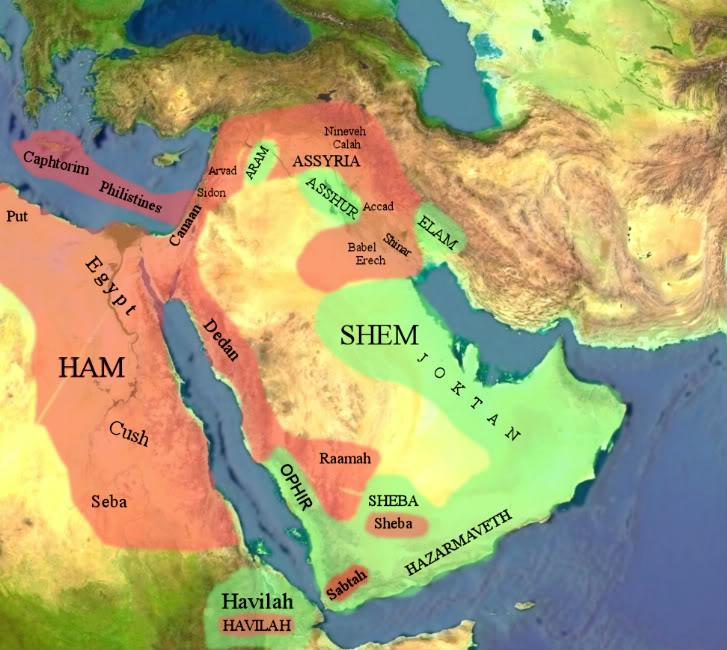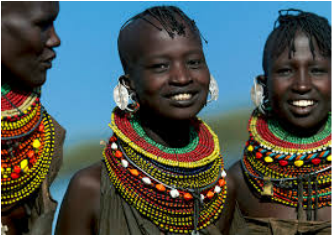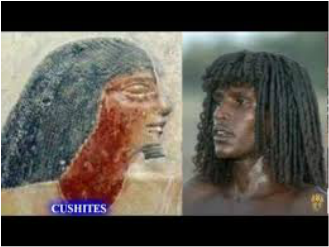Know Thyself
The ancient Abryt Yashraly (Hebrew Israelites) of the Scriptures were black and their remnant can be seen in many of the islands visited by the Trans-Atlantic Slave Trade as well as North and South America. While this information may fly in the face of all that we think we know about ourselves, civilization and what we believe about our faith, it is easily proven in the African Diaspora, antiquity, and the scriptures itself. When each is examined the truth is apparent and cannot be denied; the Hebrew people are the Negro people of the world today. This is not an assertion that ALL black people are the children of Yisra'el just that those involved in the slave trade were not the same Africans as those who sold them, but rather an entirely different nation.
The ancient Abryt Yashraly (Hebrew Israelites) of the Scriptures were black and their remnant can be seen in many of the islands visited by the Trans-Atlantic Slave Trade as well as North and South America. While this information may fly in the face of all that we think we know about ourselves, civilization and what we believe about our faith, it is easily proven in the African Diaspora, antiquity, and the scriptures itself. When each is examined the truth is apparent and cannot be denied; the Hebrew people are the Negro people of the world today. This is not an assertion that ALL black people are the children of Yisra'el just that those involved in the slave trade were not the same Africans as those who sold them, but rather an entirely different nation.
Antiquity
The Yashraly were forbidden to erect statues or images of themselves due to their faith and thus it can be difficult to discern their appearance solely through antiquity alone. Although Yashraly did not make images of themselves, many around them did and depicted them as they saw them. The walls of Mistrayim (Egypt) are littered with images of all the nations that surrounded them and the Yashraly were among them for many years, therefore, by using the depictions of nations in the halls of Mistrayim, we can develop a clear picture of the Yashraly through the eyes of Mistrayim.
The Yashraly were forbidden to erect statues or images of themselves due to their faith and thus it can be difficult to discern their appearance solely through antiquity alone. Although Yashraly did not make images of themselves, many around them did and depicted them as they saw them. The walls of Mistrayim (Egypt) are littered with images of all the nations that surrounded them and the Yashraly were among them for many years, therefore, by using the depictions of nations in the halls of Mistrayim, we can develop a clear picture of the Yashraly through the eyes of Mistrayim.
Scriptural Descriptions of Yisra'el
 The thick, woolly locks of the children of Yisra'el can be clearly seen in this Assyrian relief.
The thick, woolly locks of the children of Yisra'el can be clearly seen in this Assyrian relief.
The hair of the Yashraly people is often described in the Scriptures as woolly or bushy and many of the men had locks. This is a common feature among the black negro race and cannot be duplicated. The Book of Songs of Songs (Songs of Solomon) 5:10-11 describes Solomon through the eyes of a woman who loved him "My beloved is dazzling and ruddy, chief among ten thousand. His head is refined gold; His locks are bushy and black as a raven." Dazzling and ruddy describes a man of color with a gold or red tone as in the animal kingdom.
The Book of Bemidbar (Numbers) 6:5 describes the vow of a Nazerite who were Yashraly men and woman that set them selves apart to their creator by drinking no wine or alcohol nor did they shave. "All the days of the the vow of his separation a razor does not come upon his head. until the days are completed for which he does separate himself to YHWH, he is set-apart. He shall let the locks of the hair of his head grow long."
The Book of Shophetim (Judges, Rulers) 16:19 describes Shim'shon (Sampson), the Nazerite, and how he lost his strength. And she made him sleep on her knees, and called for a man and shaved off the seven locks of his head. If the black negro does not shave his or her head it grows into thick locks, usually 6-8 and is a distinct feature of black negro hair.
The Book of Bemidbar (Numbers) 6:5 describes the vow of a Nazerite who were Yashraly men and woman that set them selves apart to their creator by drinking no wine or alcohol nor did they shave. "All the days of the the vow of his separation a razor does not come upon his head. until the days are completed for which he does separate himself to YHWH, he is set-apart. He shall let the locks of the hair of his head grow long."
The Book of Shophetim (Judges, Rulers) 16:19 describes Shim'shon (Sampson), the Nazerite, and how he lost his strength. And she made him sleep on her knees, and called for a man and shaved off the seven locks of his head. If the black negro does not shave his or her head it grows into thick locks, usually 6-8 and is a distinct feature of black negro hair.
What the Abryt people wore
The scriptures give many accounts of what the Yashraly looked like as well as what they wore. It gives a clear description of the jewelry that they wore as well as the red sash that girdled their garments. The Book of Shemoth (Exodus) 32:2-3 And Aharon said to them, “Take off the gold earrings which are in the ears of your wives, your sons, and your daughters, and bring them to me. And all the people took off the golden earrings which were in their ears, and brought them to Aharon.”
The Book of Shemoth 39:29 describes the sash that would girdle their garments; “and a girdle of fine woven linen with blue and purple of scarlet (red) material, the work of an embroiderer, as YHWH has commanded Mosheh (Moses)."
The Book of Wayyiqra (Leviticus) 8:13 describes a bonnet worn by Israelites “And Mosheh brought the sons of Aharon and put long shirts on them, and girdled them with girdles, and put turbans on them, as YHWH had commanded Mosheh.”
The Book of Bemdibar (Numbers) goes into further detail in regards to the garments of the people of Yisra'el in 15:38 “Speak to the children of Yisra'el, and tell them to make tzitzit (fringes) on the borders of their garments throughout their generations, and that they put a blue cord in the corners of the tzitzit.”
The Book of Shemoth 39:29 describes the sash that would girdle their garments; “and a girdle of fine woven linen with blue and purple of scarlet (red) material, the work of an embroiderer, as YHWH has commanded Mosheh (Moses)."
The Book of Wayyiqra (Leviticus) 8:13 describes a bonnet worn by Israelites “And Mosheh brought the sons of Aharon and put long shirts on them, and girdled them with girdles, and put turbans on them, as YHWH had commanded Mosheh.”
The Book of Bemdibar (Numbers) goes into further detail in regards to the garments of the people of Yisra'el in 15:38 “Speak to the children of Yisra'el, and tell them to make tzitzit (fringes) on the borders of their garments throughout their generations, and that they put a blue cord in the corners of the tzitzit.”
African/Abryt Diaspora

The beginning of the Hebrew migration into Africa was the Bantu migration and started long before the events of the Messianic Writings (New Testament) and can be easily verified in both the African and Hebrew Diaspora. After the flood, the sons of Noahk (Noah) were responsible for populating the earth with the current form of mankind. This divided humanity by their nations or nationality, but not language at this point. According to the regional history as well as the Scriptures, Mankind fell into the category of Shemite (Shem), Khamite (Ham), and Yahphite (Japheth) and after the Babel incident they split into three areas by lot. Book of Yahubelim (Jubilees) 8:11 "and he called his sons, and they drew near to him, they and their children, and he divided the earth into the lots, which his three sons were to take in possession". (see origins of religion)
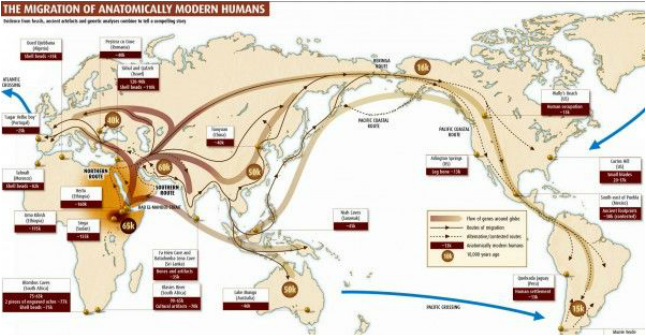
The most widely accepted theory of the geographical origin and early migration process of anatomically modern humans is the Out of Africa Theory (OAT) which is another instance of science and knowledge reproving scripture. Almost all geneticists, archeologists, and historians agree that the first forms of humanity had to be black and originated from east Africa, specifically near the horn of Africa. "A geographically explicit genetic model of worldwide human-settlement history". Am. J. Hum. Genet. 79 (2): 230–7. "This week in Science: Out of Africa Revisited". Science 308 (5724): 921. 2005-05-13. Stringer C (June 2003). "Human evolution: Out of Ethiopia". Nature 423 (6941): 692–3, 695. Johanson D. "Origins of Modern Humans: Multiregional or Out of Africa?” ActionBioscience. American Institute of Biological Sciences.

Zondervan, one of the founding members of the Evangelical Christian Publishers Association (ECPA) is the most commonly accepted publishing house of bibles for Christians and revered as a reputable biblical scholastic source. The Zondervan bible dictionary defines the three sons of Noah as such:
Shem- (name, fame, or character) a son of Noah, and the progenitor of the Shemitic (later Semitic) races, born 98 years before the flood (Gen 11:10) and lived six hundred years, outliving his descendants for nine generations except Eber and Abraham.
Ham (Kham) - (hot, burned by heat) a son of Noah, probably born 96 years before the flood (his date of birth is unclear); and one of the eight people to survive the flood on the ark. He became the progenitor of the dark races; NOT THE NEGROES, but the Egyptians, Ethiopians, Libyans and Canaanites (Gen. 10:6-20). His son Canaan was cursed by Noah to be a servant of servants (Gen. 9:20-27).
Japheth (Yahphet) - (increased or enlarged by YHWH) a son of Noah (Gen. 5:32; 6:10; 7:13; 10:21); had seven sons (Gen. 10:2); descendants occupied “Isles of Gentiles” (Greeks and Europeans) (Gen. 10:5); blessed by Noah (Gen. 9:20- 27).
Shem- (name, fame, or character) a son of Noah, and the progenitor of the Shemitic (later Semitic) races, born 98 years before the flood (Gen 11:10) and lived six hundred years, outliving his descendants for nine generations except Eber and Abraham.
Ham (Kham) - (hot, burned by heat) a son of Noah, probably born 96 years before the flood (his date of birth is unclear); and one of the eight people to survive the flood on the ark. He became the progenitor of the dark races; NOT THE NEGROES, but the Egyptians, Ethiopians, Libyans and Canaanites (Gen. 10:6-20). His son Canaan was cursed by Noah to be a servant of servants (Gen. 9:20-27).
Japheth (Yahphet) - (increased or enlarged by YHWH) a son of Noah (Gen. 5:32; 6:10; 7:13; 10:21); had seven sons (Gen. 10:2); descendants occupied “Isles of Gentiles” (Greeks and Europeans) (Gen. 10:5); blessed by Noah (Gen. 9:20- 27).
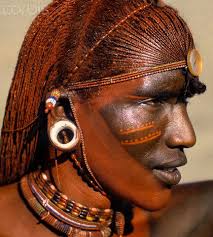
The Khamites (Hamites) made up all of the dark races except the Negro and settled mostly in the land of Khemet, which was the land of dark people or people burned by heat. The term Egypt was a name used by the Greeks who mistakenly thought the Second name of the City of Thebes, "Aigyptos" was the name of the land established by Kham’s son Mistrayim (encloser or embanker of the sea). He was the first king of what we now call Egypt, whose allotted land was along the Nile and he was named as such for embanking the upper Nile, which was flooded, thus creating the Nile delta.
The only way the Scriptures make sense is if the Hebrew people looked like the people of Khamet (Mistrayim or Egypt)
- The fact that Yosef (Joseph) was sold into slavery into Mistrayim (Egypt) and was virtually indistinguishable from the Mistrians is testament to his appearance. His brothers could not tell them apart because they looked like the same nation/nationality (Gen. 42:7-8).
- In the case of Moshe or Moses (drawn out of water), he was taken out of the water by the daughter of the Pharaoh and passed off as her own child during a time when her father was having all the Hebrew males killed (Gen. 2:5-10). How was he able to pass off as a Mistrian, who were sons of Kham, without the Pharaoh discovering him and subsequently killing him?
- When Ya’aqob (Jacob) died, was mourned and then buried in Abraham’s tomb in the land of Kena’an (Canaan), the Kena’anites saw the funeral procession and said “This is a grievous mourning for the Mistrites” (Gen. 50:1-11). Why would it not read this is a grievous mourning for the Hebrews?
- When Yosef and Miryam (Mary) were attempting to flee the wrath of Herodes (Herod) as commanded by a messenger (angel) of YHWH, because he wanted to destroy the child, why were they told to flee into Mistrayim and hide (Matt. 2:1-13)?
- To outsiders they were no different than the same people. Each time the children of Yisra’el fled annihilation they went west towards Mistrayim because they could easily blend in and disappear.
The children of Ya’aqob or as they were later known, Yisra’el, set up lands for themselves in the allotted areas designated by Noahk in what is present day Palestine. Slavery is a common theme all throughout the Scriptures and is the typical punishment for transgressions (breaking of the laws or sins) against the creator YHWH Elohim. One simple way a faithful person could identify the children of Yisra'el is via the curses set upon them from the Book of Debarim (Deuteronomy) 28:1-68 for disobeying or transgressing the law, which happened each generation even until this day. After inspection and reflection, there can be little doubt as to who fits these curses and they are indeed a wonder for the whole world to identify those whom the creator cursed for disobedience and NO ONE else can claim to have endured the wrath written in the Torah except the true children of Yisra’el.










